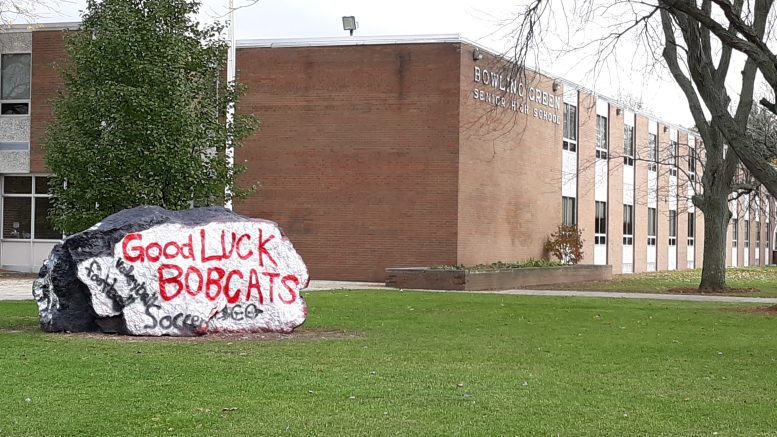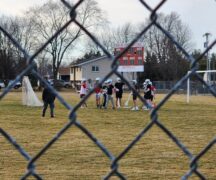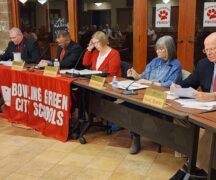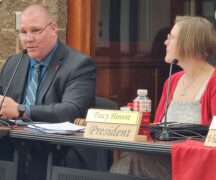By JAN LARSON McLAUGHLIN
BG Independent News
Every time voters turn down school building levies, the Bowling Green community loses far more than just a new building.
The district is losing families, businesses, economic development – and most importantly, the chance to provide modern and safe learning environments for its children, according to a group wanting different results on future ballots.
The small group of parents, young professionals and local business owners has been meeting weekly since January to do what they can to stop the slide. They have watched as young families leave BG out of frustration and desire to give their children the best learning environments possible. They have been part of economic development discussions, where top employers like Wood County Hospital and Bowling Green State University address their difficulties getting people to move here because of the out-of-date school facilities.
So rather than sitting on the sidelines this time around, the newly formed Bowling Green Families for Schools group has offered its help to the BG Board of Education as the district prepares to possibly put a levy for a new high school on the November ballot.
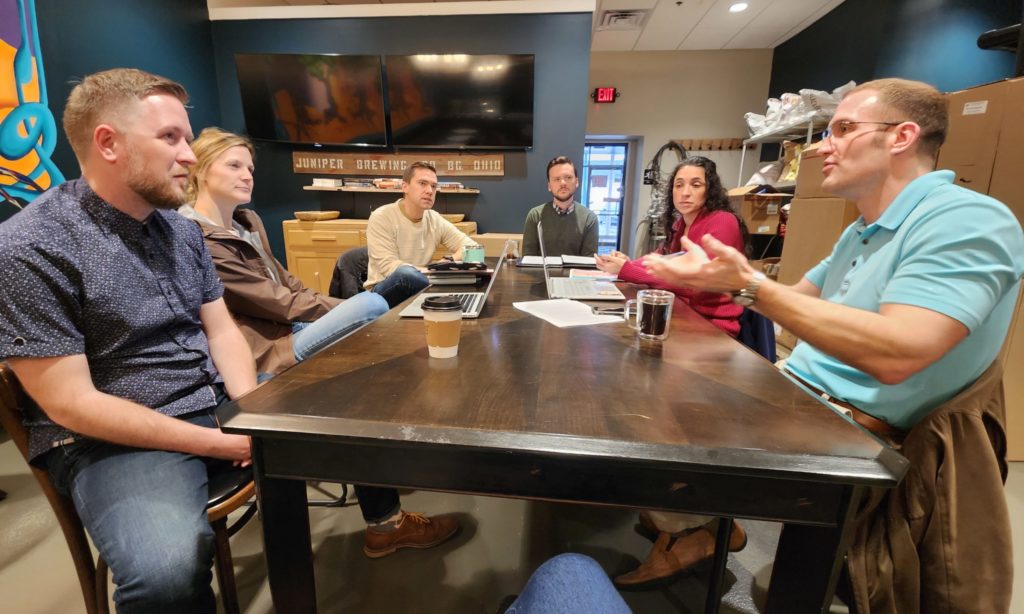
Who’s making the effort
The group of Bowling Green parents, young professionals and local business owners meeting to work toward a new high school includes: Will Airhart, Crim parent; Jeff Dennis of Bowling Green City Council; Joe Higgins, Kenwood parent; Trevor Jesse, of BG Board of Public Utilities; Andy Newlove, of Newlove Realty; Rachel Phipps of Bowling Green City Council; Ryan Phipps, of Phipps Levin Hebeka & Associates; Amy Simmons, of Hub Group; Nate. Spitler of Spitler Huffman; and Christina Spitler of Wonderland of Learning School Age Center.
They welcome the help of other district residents who share their concerns. Those interested may visit www.bgffs.com.
Top priority – students
The current high school building, constructed 60 years ago, is outdated and overcapacity, according to the BG Families for Schools.
The continued non-support of building levies has created overcrowded classrooms and limited opportunities for students. A new building will alleviate these issues and provide a state-of-the-art learning environment that better prepares children to compete for the jobs of tomorrow.
Those accommodations are already available in neighboring districts that have invested in new buildings.
“We have a responsibility to provide our kids with modern, safe and secure learning environments,” Dennis said.
The lack of support by voters is affecting students more than academically. As students travel to other districts in the county for sports, music or other competitions, they see the glaring difference in the facilities that residents of other districts provide for their youth.
“I get those comments every week,” said Ryan Phipps, who sees a lot of Bowling Green City School students in his dental practice.
Sometimes old isn’t historic … it’s outdated
Competition is brutal as school districts tout their benefits to attract new students and their tax paying families. No matter how good Bowling Green City Schools’ teachers are – the school buildings themselves get failing grades next to neighboring schools.
So how does Bowling Green High School compare in age to other high schools in the county? Following is a list of the districts with the years their high schools were constructed:
- Bowling Green – 1963 (addition without remodel early 1990s)
- Eastwood – 2000 (significant remodel and addition)
- Perrysburg – 2001 new high school
- Elmwood – 2004 new high school
- Otsego – 2007 new high school
- North Baltimore – 2012 new high school
- Rossford – 2020 new high school
Those other districts also have newer elementary schools, but the BG Families for Schools group believes the high school should be the priority. A new high school is a necessary investment that the community cannot afford to put off any longer, according to BGFFS members.
“We’ve put bandaids on things for 20 years,” Nate Spitler said.
“We’re living in a rapidly changing world,” and Bowling Green isn’t keeping up with those changes, Dennis said.
BG residents pay less than neighbors
Residents of the Bowling Green district currently contribute less to their schools than all surrounding districts.
According to figures from the Wood County Auditor’s Office in January, if BG voters were to pass a $70 million levy, that would increase property taxes by $274 annually for the owner of a $150,000 home. That would still be less than most of the surrounding districts.
Based on a $150,000 home and a $60,000 income, a taxpayer in BG’s district currently annually pays:
- $126 less than the equivalent taxpayer in Elmwood.
- $216 less than in Otsego.
- $318 less than in Eastwood.
- $498 less than in Fostoria.
- $570 less than in Rossford.
- $834 less than in North Baltimore.
- $1,125 less than in Perrysburg.
“We’ve been underfunding our schools for a long time,” Spitler said.
As for the options of property or income tax, Dennis said he would be hard pressed to seek an income tax which places a greater burden on low income residents. Afterall, he said, property owners will see the most benefit with increased economic development and rising property values.
“We’re going to see the greatest return,” Dennis said.
‘Brain drain’
Members of BGFFS have several stories of young families – their counterparts in the community – who have left the district out of concern over the school district’s buildings that are well over 50 years old.
“We’ve all had friends who moved and chose not to stay here because of the condition of the school buildings,” Spitler said. “We’re seeing the impact of failed levies over several years.”
The group – with four of them BGHS grads themselves – want to stop that exodus of families.
“I personally have seen good families leave,” Ryan Phipps said. “I feel a sense of urgency now. It’s happening at alarming rates.”
Stagnant growth
A new high school would not only benefit students – but also boost the economic development of the Bowling Green area, the members said.
“Good schools are important to the viability of a city,” Spitler said.
“Schools are one of the key economic engines for a small community,” Rachel Phipps said.
They cited discussions in which major employers in the city – who try to attract young professionals to Bowling Green – just can’t fight the fact the school district is behind in providing new well-equipped facilities.
“Schools are a pillar of that conversation,” Jesse said, noting that many employees commute to Bowling Green for work, but live in other school districts because of the newer facilities.
Bowling Green was able to win a major new manufacturer last year, making an announcement that Abbott Laboratories was building here – and bringing 450 new jobs.
While that’s fabulous news for the city, Dennis said, the community needs to provide a better high school if it wants to attract the families of those new employees.
“They are going to be looking at places like Otsego, Perrysburg and Pemberville,” he said. “Those communities stand to gain at our expense.”
Good school facilities also help the city provide good services, he stressed. Voters need to connect the dots between investing in their schools and the services provided by city government – like police and fire, streets and sidewalks, and utility services, Dennis said.
“We see those effects in the condition of our sidewalks,” and other city expenses, he said. “It is very much a long-term investment that will pay dividends into the future.”
Where BGCS has been before
In November 2017 and in May 2018, a $72 million bond issue failed that would have renovated and expanded the high school, plus paid for the construction of one new elementary school.
Last year, a district facilities advisory committee recommended a new high school issue be put on the ballot. Ninety-five percent of the committee agreed that building a new high school was the priority. The combination income/property tax issue to raise $70 million for a high school failed in November.
The group supporting the schools believes now is a critical time for the district to move forward and to stop the loss of families. The cost will never be less than it is now.
“It’s only going to get more expensive,” Spitler said.
No more quiet campaign
Members of the BG Families for Schools want to get information out about the current deficiencies of the high school, the impact on students, and the effect on economic development.
They want voters to have information on how much a new school would cost them, as well as how much it’s costing the community to not support levies.
The BGFFS wants to rally the district, Jesse said.
In the past levy attempts, the rural areas of the school district have soundly voted down any building issue – whether it’s been a property tax or combined income/property tax. Members of the BGFFS want all parts of the district to fully grasp the benefits of a new high school.
“We all benefit from strong public schools,” Dennis said.
What’s new this time around?
Some voters throughout the district have pinned their “no” votes on past building issues on their distrust or dislike of the current school board and administration. Superintendent Francis Scruci is retiring this summer, and board members Jill Carr and Ginny Stewart have announced that they do not plan to run for re-election in November.
“This is a new project of a new administration,” Ryan Phipps said.
“We really need to look forward,” Dennis said.
The BGFFS is interested in supporting new school board candidates, who believe in the value of new school facilities.
How to get involved
Go to https://docs.google.com/forms/d/e/1FAIpQLSfY7TT8-WFrAsq1SiIs2dxDV_V_UE0RQDYxZ_GBNHXVrFdtdQ/viewform

